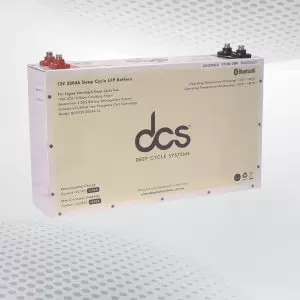In today’s rapidly evolving energy landscape, the importance of efficient and reliable power storage solutions cannot be overstated. One of the most critical components in this arena is the deep cycle battery. Unlike conventional batteries that provide short bursts of energy, deep-cycle batteries are designed to be discharged and recharged repeatedly, making them an ideal choice for various applications that require a sustained power supply. This blog post delves into deep-cycle batteries, exploring their types, applications, benefits, maintenance, common issues, and future trends.
Understanding What a Deep-Cycle Battery Is
A deep-cycle battery is engineered to deliver a consistent and sustained power output over an extended period. This sets them apart from starter batteries, designed to provide short, high-current bursts to start engines. The construction of deep-cycle batteries includes thicker plates and more robust materials, which allow them to endure repeated deep discharges and recharges. These batteries are particularly suited for applications where a long-lasting and reliable power source is crucial. For example, deep-cycle batteries provide the necessary power for continuous operation in renewable energy systems, electric vehicles, and marine applications.
The ability to withstand deep discharges means deep-cycle batteries can deplete most of their stored energy without damage, unlike standard batteries that could suffer from reduced lifespan or performance when deeply discharged. This makes them an excellent choice for applications that require a dependable and long-lasting power supply. Additionally, these batteries come in various types, such as flooded lead-acid, AGM (Absorbent Glass Mat), and lithium-ion, each offering different advantages depending on the specific needs and conditions of the application.
Flooded lead-acid deep-cycle batteries are typically the most cost-effective option but require regular maintenance, such as checking electrolyte levels. AGM batteries, on the other hand, are maintenance-free and offer better performance in extreme conditions. Lithium-ion deep-cycle batteries provide the highest efficiency and longest lifespan but come at a higher upfront cost. Understanding each type’s unique characteristics and requirements can help you select the most suitable deep-cycle battery for your needs.
Different Types of Deep-Cycle Batteries Explained
Flooded Lead-Acid Batteries
Flooded lead-acid batteries are the most traditional type of deep-cycle battery. They consist of liquid electrolytes that submerge the battery’s lead plates. These batteries are known for their affordability and durability, making them a popular choice for various applications. However, they require regular maintenance, such as topping off the electrolyte levels and ensuring proper ventilation to avoid the buildup of explosive gases. Flooded lead-acid batteries are well-suited for situations where cost-effectiveness is a priority and regular maintenance is manageable.
Absorbent Glass Mat (AGM) Batteries
AGM batteries are an advanced type of lead-acid battery that uses a fibreglass mat to absorb the electrolyte, preventing it from spilling even if it is damaged. These batteries are maintenance-free and perform better in extreme temperatures than their flooded counterparts. AGM batteries also have a lower self-discharge rate, meaning they can charge longer when not in use. This makes them ideal for applications where maintenance access is limited or where reliable performance in varying conditions is crucial.
Gel Cell Batteries
Gel cell batteries are another variation of lead-acid batteries, where the electrolyte is a gel. This design reduces the risk of leakage and makes the battery more resistant to vibration and shock. Gel cell batteries are commonly used in environments where reliability and durability are essential, such as marine and off-road applications. They also require minimal maintenance and can perform well in various temperatures, although they generally have a lower power density than AGM and lithium-ion batteries.
Lithium-ion batteries represent the latest in deep-cycle battery technology. They offer the highest energy efficiency, longest lifespan, and require the least maintenance. Lithium-ion batteries are lightweight and can deliver more cycles than lead-acid batteries, making them ideal for high-demand applications like electric vehicles and renewable energy systems. While the initial cost is higher, their long-term benefits often justify the investment. These batteries also have advanced management systems that optimize performance and ensure safety.
Key Applications of Deep-Cycle Batteries
Deep-cycle batteries are extensively used in various applications that demand a reliable and sustained power supply. One of the most prominent applications is in renewable energy systems, such as solar and wind power setups, where they store excess energy generated during peak production times for use during periods of low generation.
In the automotive industry, deep-cycle batteries are essential for electric vehicles (EVs) and hybrid electric vehicles (HEVs), providing the necessary energy for propulsion and auxiliary systems. Marine applications also heavily rely on deep-cycle batteries to power navigation systems, lights, and other onboard electronics during long voyages. Similarly, recreational vehicles (RVs) utilize these batteries to run appliances, lighting, and other electrical systems, ensuring comfort and convenience during travel.
Another critical application is in uninterruptible power supplies (UPS) and backup power systems for homes, businesses, and critical infrastructure. These batteries ensure that essential services remain operational during power outages. Deep-cycle batteries are also used to power equipment such as forklifts and other material-handling machinery in industrial settings. Their ability to deliver consistent power over long periods makes them ideal for these demanding environments.
Benefits of Using a Lithium Battery
Lithium battery boasts exceptional energy efficiency, with a higher charge and discharge efficiency than traditional lead-acid batteries. This means that a greater proportion of the energy stored is usable, minimizing energy losses and making them more cost-effective in the long run.
One of the standout benefits of lithium-ion deep-cycle batteries is their extended lifespan. These batteries can handle a significantly higher number of charge and discharge cycles before their capacity degrade, offering more value over time. This makes them particularly advantageous for applications where battery replacement is difficult or costly.
Lithium-ion batteries are considerably lighter than their lead-acid counterparts, making them easier to transport and install. This lightweight design is especially beneficial for mobile applications such as electric vehicles, marine vessels, and recreational vehicles, where reducing weight can improve overall performance and efficiency.
Lithium-ion deep-cycle batteries require minimal maintenance, eliminating the need for regular checks and fluid top-ups that are necessary with flooded lead-acid batteries. This low-maintenance aspect reduces the overall operational burden, making them an ideal choice for applications where ease of use is a priority.
How to Properly Maintain Your Deep-Cycle Battery
Proper maintenance is essential to maximize the lifespan and performance of your deep-cycle battery. Here are some maintenance tips:
Regular Charging
Charge your deep-cycle battery regularly to prevent deep discharges. Frequent deep discharges can reduce the battery’s overall lifespan and efficiency. Use a smart charger to automatically adjust the charging rate to prevent overcharging.
Check Fluid Levels
If you’re using flooded lead-acid batteries, checking the electrolyte levels periodically is crucial. Top off the cells with distilled water as needed, ensuring that the plates are always submerged to avoid damage.
Clean Terminals
Keep the battery terminals clean and corrosion-free. Corrosion can impede electrical connections, reducing the battery’s performance. Use baking soda and water to clean the terminals, and apply a terminal protector to prevent future buildup.
Temperature Monitoring
Store and operate your batteries within the recommended temperature range. Extreme temperatures can negatively impact battery performance and longevity. Consider using battery insulators or thermal management systems in environments with fluctuating temperatures.
Regular Inspections
Periodically inspect the battery for any signs of damage, leaks, or bulging. Identifying and addressing issues early can prevent more significant problems down the line.
Avoid Over-Discharging
Set a discharge limit to avoid over-discharging your battery. For most deep-cycle batteries, the charge should not drop below 50%.
Proper Storage
If the battery will be stored for an extended period, ensure it is fully charged and kept in a cool, dry place. Check the charge level periodically and recharge as necessary to maintain optimal performance.
Common Issues and Troubleshooting Tips
Deep-cycle batteries, while reliable, can experience several common issues. One prevalent problem is sulfation, where lead sulphate crystals build up on the battery plates, reducing capacity and performance. To address this, use a desulfator device or follow a controlled overcharging process to dissolve the crystals. Another issue is overheating, which can occur if the battery is overcharged or exposed to high temperatures. Ensure proper ventilation and use temperature-regulated chargers to prevent this. Corrosion on battery terminals is common and can lead to poor electrical connections. Clean the terminals regularly with a baking soda and apply terminal grease to inhibit future corrosion.
Additionally, users might encounter a phenomenon known as “battery memory” in certain batteries, where incomplete discharge cycles lead to reduced capacity. Performing periodic full discharge cycles can help mitigate this. Finally, if a battery fails to hold a charge, it may be due to age or internal damage. Conduct a load test to determine if the battery needs replacement. Regular maintenance and monitoring can preempt many of these issues, ensuring the longevity and efficiency of your deep-cycle battery.
Future Trends and Innovations in Deep-Cycle Battery Technology
The deep-cycle battery industry is seeing significant advancements to boost performance and sustainability. One major trend is the development of solid-state batteries, which promise enhanced safety and higher energy density than traditional liquid-electrolyte designs. Solid-state batteries could revolutionize the market by offering longer lifespans and faster charging times. Additionally, smart battery management systems are becoming more sophisticated, providing real-time monitoring and optimization of battery performance, which can extend the usable life of batteries and improve overall efficiency.
Another exciting innovation is the improvement in recycling technologies. As the adoption of deep-cycle batteries grows, there’s an increasing focus on creating efficient methods to recover valuable materials, reducing environmental impact, and promoting circular economy principles. Researchers are also exploring alternative materials, such as silicon and sulphur cathodes, to enhance battery capacity and reduce costs.
These trends and innovations highlight the dynamic nature of the deep-cycle battery sector, with ongoing research and development aimed at addressing current limitations and meeting future energy storage needs.
Conclusion
A Deep cycle battery is pivotal in today’s energy landscape, supporting diverse applications ranging from renewable energy systems to electric vehicles and marine uses. Their ability to deliver sustained and reliable power makes them indispensable for everyday and specialized needs. By understanding the nuances of different types—such as flooded lead-acid, AGM, gel cell, and lithium-ion batteries—users can select the most appropriate battery for their specific requirements. These batteries offer numerous benefits, including high energy efficiency, a longer lifespan, lightweight design, and low maintenance, especially when opting for advanced lithium-ion models.
FAQs
Q: What is the main difference between deep-cycle and regular car batteries?
A: Deep-cycle batteries are designed for sustained power output over long periods, whereas regular car batteries provide short bursts of high-current to start engines.
Q: How often should I check the electrolyte levels in my flooded lead-acid deep-cycle battery?
A: It’s recommended to check the electrolyte levels at least once a month and top off with distilled water as needed.
Q: Can a deep cycle battery be used to start engines?
A: While possible, deep-cycle batteries are not optimized to provide the high-current bursts needed to start engines. Starter batteries are better suited for that purpose.
Q: How do I know when my deep-cycle battery needs replacement?
A: Signs include significantly reduced capacity, inability to hold a charge, or visible damage such as swelling or leaking.
| Related Business Listings |
| Contact Directory |
| Local Business Profiles |

